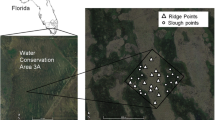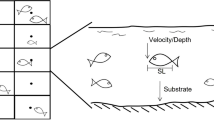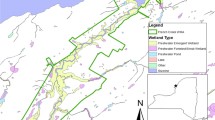Summary
Surveys of 262 pools in 3 small streams in eastern Tennessee demonstrated a strong positive relationship between pool depth and the size of the largest fish within a pool (P<0.001). Similarly, the largest colonizers of newly-created deep pools were larger than the colonizers of shallow pools. We explored the role of predation risk in contributing to the “bigger fish — deeper habitat” pattern, which has been noted by others, by conducting five manipulative field experiments in two streams. Three experiments used stoneroller minnows (Campostoma anomalum); one used creek chubs (Semotilus atromaculatus); and one used striped shiners (Notropis chrysocephalus). The stoneroller experiments showed that survival of fish approximately 100 mm in total length (TL) was much lower in shallow pools (10 cm deep) than in deep (40 cm maximum) pools (19% versus 80% survival over 12 d in one experiment) and added cover markedly increased stoneroller survival in shallow pools (from 49% to 96% in an 11-d experiment). The creek chub experiment showed that, as for stonerollers, pool depth markedly influenced survival: the chubs survived an average of 4.9 d in shallow pools and >10.8 d in deep pools. In the striped shiner experiment in shallow artificial streamside troughs, no individuals 75–100 mm TL survived as long as 13 d, where-as smaller (20–25 mm) fish had 100% survival over 13 d. The results of the experiments show that predation risk from wading/diving animals (e.g., herons and raccoons) is much higher for larger fishes in shallow water than for these fishes in deeper water or for smaller fish in shallow water. We discuss the role of predation risk from two sources (piscivorous fish, which are more effective in deeper habitats, and diving/wading predators, which are more effective in shallow habitats) in contributing to the bigger fish — deeper habitat pattern in streams.
Similar content being viewed by others
References
Clapp RB, Frederick BJ (1989) Precipitation and streamflow in the vicinity of West Chestnut Ridge near Oak Ridge National Laboratory, Oak Ridge, Tennessee (October 1985–March 1988). ORNL/TM-10936
Fraser DF, Emmons EE (1984) Behavioral response of blacknose dace (Rhinichthys atratulus) to varying densities of predatory creek chub (Semotilus atromaculatus). Can J Fish Aquat Sci 41:364–370
Gilliam JF, Fraser DF (1987) Habitat selection under predation hazard: test of a model with foraging minnows. Ecology 68:1856–1862
Gorman OT (1987) Habitat segregation in an assemblage of minnows in an Ozark stream. In: Matthews WJ, Heins DH (eds) Community and evolutionary ecology of North American stream fishes. University of Oklahoma Press, Norman, OK, pp 33–41
Grossman GD, Freeman MC (1987) Microhabitat use in a stream fish assemblage. J Zool Lond 212:151–176
Grossman GD, deSostoa A, Freeman MC, Lobon-Cervia J (1987a) Microhabitat use in a mediterranean riverine fish assemblage. Fishes of the lower Matarrana. Oecologia73:490–500
Grossman GD, deSostoa A, Freeman MC, Lobon-Cervia J (1987b) Microhabitat use in a mediterranean riverine fish assemblage. Fishes of the upper Matarrana. Oecologia 73:501–512
Harvey BC (1987) Susceptibility of young-of-the-year fishes to downstream displacement by flooding. Trans Am Fish Soc 116:851–855
Harvey BC, Cashner RC, Matthews WJ (1988) Differential effects of largemouth and smallmouth bass on habitat use by stoneroller minnows in stream pools. J Fish Biol 33:481–487
Harvey BC (1991) Interactions among stream fishes: predator-induced habitat shifts and larval survival. Oecologia 87:29–36
Huryn AD, Wallace JB (1987) Local geomorphology as a determinant of macrofaunal production in a mountain stream. Ecology 68:1932–1942
Loar JM (1990) Third Annual Report on the ORNL Biological Monitoring and Abatement Program. Draft ORNL/TM Report, Oak Ridge National Laboratory, Oak Ridge, Tennessee, USA
Mahon R, Portt CB (1985) Local size related segregation of fishes in streams. Arch Hydrobiol 103:267–271
Moyle PB, Baltz DM (1985) Microhabitat use by an assemblage of California stream fishes: developing criteria for instream flow determinations. Trans Am Fish Soc 114:695–704
Moyle PB, Vondracek B (1985) Persistence and structure of the fish assemblage in a small California stream. Ecology 66:1–13
Power ME (1984) Depth distributions of armored catfish: predator-induced resource avoidance? Ecology 65:523–528
Power ME, Matthews WJ, Stewart AJ (1985) Grazing minnows, piscivorous bass and stream algae: dynamics of a strong interaction. Ecology 66:1448–1456
Power ME (1987) Predator avoidance by grazing fishes in temperate and tropical streams: importance of stream depth and prey size. In: Kerfoot WC, Sih A (eds) Predation: direct and indirect impacts on aquatic communities. University Press of New England, Hanover, NH, pp 333–351
Power ME, Dudley T, Cooper S (1989) Grazing catfish, fishing birds, and attached algae in a Panamanian stream. Env Biol Fish 26:285–294
Schlosser IJ (1982) Fish community structure and function along two habitat gradients in a headwater stream. Ecol Monogr 52:395–414
Schlosser IJ (1985) Flow regime, juvenile abundance and the assemblage structure of stream fishes. Ecology 66:1484–1490
Schlosser IJ (1988a) Predation rates and the behavioral response of adult brassy minnows (Hybognathus hankinsoni) to creek chub and smallmouth bass predators. Copeia 1988:691–697
Schlosser IJ (1988b) Predation risk and habitat selection by two size classes of a stream cyprinid: experimental test of a hypothesis. Oikos 52:36–40
Stewart AJ, Kszos LA, Harvey BC, Wicker LF, Haynes GJ, Bailey RD (1990) Ambient toxicity dynamics: Assessments usingCeriodaphnia dubia and fathead minnow (Pimephales promelas) larvae in short-term tests. Env Toxicol Chem 9:367–379
U.S. Department of Energy (1984) Draft Environmental Impact Statement for the Central Waste Disposal Facility for Low-Level Radioactive Waste, DOE/EIS-0110-D
Author information
Authors and Affiliations
Rights and permissions
About this article
Cite this article
Harvey, B.C., Stewart, A.J. Fish size and habitat depth relationships in headwater streams. Oecologia 87, 336–342 (1991). https://doi.org/10.1007/BF00634588
Received:
Accepted:
Issue Date:
DOI: https://doi.org/10.1007/BF00634588




